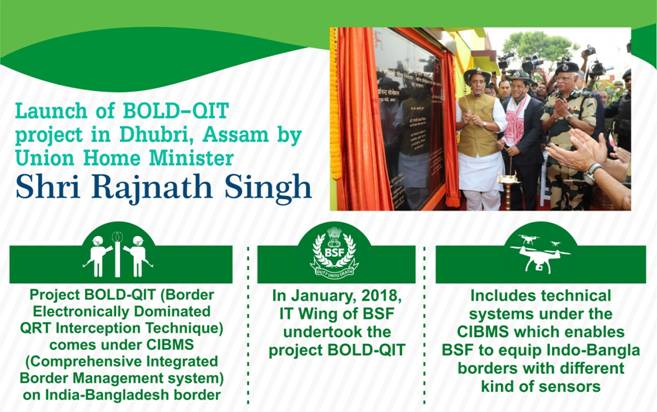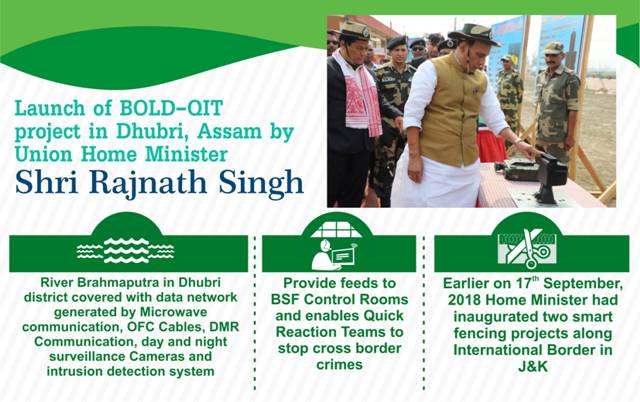Union Home Minister launches Smart Fencing on Indo-Bangladesh border, an effective deterrence against illegal infiltration
Two pilot projects covering about 71 Kms on Indo-Pakistan Border (10 Kms) and Indo-Bangladesh Border (61 Kms) of Comprehensive Integrated Border Management System (CIBMS) have been completed. The Stage has been set now for taking up Stage-II and Stage-III covering about 1955 Kms of the border which cannot be physically fenced. The CIBMS project will vastly improve the capability of BSF in detecting and controlling the cross border crimes like illegal infiltration, smuggling of contraband goods, human trafficking and cross border terrorism etc.
Union Home Minister Shri Rajnath Singh inaugurated the project BOLD-QIT (Border Electronically Dominated QRT Interception Technique) under Comprehensive Integrated Border Management System (CIBMS) on Indo- Bangladesh border in Dhubri district of Assam today. Interacting with media persons, Shri Rajnath Singh said earlier in the month of September, 2018, two pilot projects of “smart” border fencing built under the CIBMS programme in Jammu were operationalised. He added that over a period of time the complete border will be covered.
At Dhubri, where BOLD-QIT project has been implemented along riverine border, it was not feasible to construct border fencing. The 61 kms of border area in Dhubri where River Brahmaputra enters into Bangladesh consists of vast char lands and innumerable river channels thus making border guarding in this area a challenging task especially during rainy season.
To address these problems Ministry of Home Affairs has decided to use technological solutions to enhance capabilities of manpower of Border Security Force (BSF) deployed on the ground. As part of CIBMS, these two projects were undertaken. Implementation of this project will help in integration of manpower, sensors, networks, intelligence and command and control solutions to improve situational awareness at different levels of hierarchy to facilitate prompt and informed decision making and quick reaction to emerging situations.

CIBMS involves deployment of a range of state-of-the-art surveillance technologies — thermal imagers, infra-red and laser-based intruder alarms, aerostats for aerial surveillance, unattended ground sensors that can help detect intrusion bids, radars, sonar systems to secure riverine borders, fibre-optic sensors and a command and control system that shall receive data from all surveillance devices in real time. Implementation of CIBMS projects on Indo - Pakistan and Indo - Bangladesh border will enhance the capabilities of Border security Force (BSF).

The total rollout plan for CIBMS is as under :-
Stage-I Pilot projects in Jammu and Assam has been completed.
Stage-II Rollout of 153 Kms in 4 patches along Indo-Pakistan & Indo-Bangladesh Border.
Stage-III Rollout of 1802 Kms in 67 patches along Indo-Pakistan & Indo-Bangladesh border.
Stage-I of the project on pilot basis has been completed. Stage-I will be reviewed through an independent third party auditor (IIT Delhi). Stage-II & III will target primarily the following areas:
- Riverine, delta and estuary areas
- Waterlogged and swampy areas
- Creek areas
- Plain areas vulnerable to heavy fog
- Thickly populated areas on the border
- Hilly areas
- Tropical jungle areas
- Deserts
*****
BB/NK/PK/SS